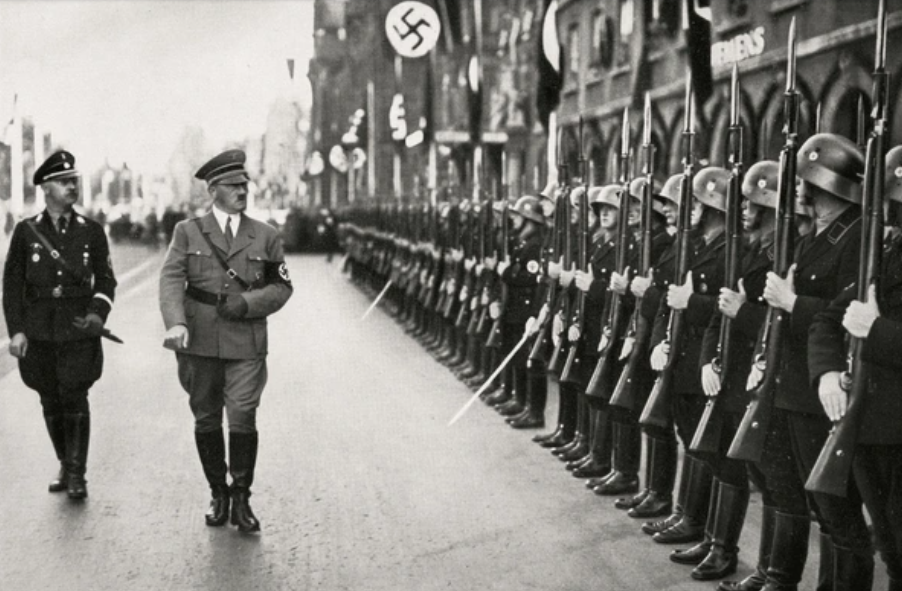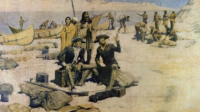Introduction: The Architect of Global Conflict
Adolf Hitler, as the Führer of Nazi Germany, was the primary architect behind the outbreak and progression of World War II. His strategic decisions, often driven by ideological convictions and a desire for territorial expansion, played a crucial role in shaping the course of the conflict. From the invasion of Poland in 1939, which triggered the war, to his increasingly erratic and desperate military commands in the final days of the Third Reich, Hitler’s influence on the war’s trajectory was profound and far-reaching.
Understanding Hitler’s role in World War II requires an analysis of his strategic goals, military decisions, and the impact of his leadership style on the effectiveness of the German war effort. His determination to impose his vision of a new European order, coupled with his strategic miscalculations, ultimately led to the destruction of Nazi Germany and altered the course of global history.
Read Also : The Rise of Adolf Hitler (1919-1933): From Obscurity to Dictatorship
The Outbreak of War: Strategic Calculations and Misjudgments
Hitler’s decisions in the lead-up to and during the early years of World War II were instrumental in the rapid escalation of the conflict.
The Invasion of Poland: The Catalyst for Global War
The invasion of Poland on September 1, 1939, marked the beginning of World War II. Hitler’s decision to invade was driven by a desire to regain lost territories, expand German Lebensraum (living space), and assert dominance over Eastern Europe. The non-aggression pact with the Soviet Union, known as the Molotov-Ribbentrop Pact, allowed Hitler to launch the invasion without fear of immediate retaliation from the east.
Hitler’s strategic calculation was that Britain and France, despite their guarantees to Poland, would be reluctant to engage in another full-scale war so soon after the devastation of World War I. However, this proved to be a significant misjudgment. Both Britain and France declared war on Germany on September 3, 1939, setting the stage for a global conflict.
The swift and brutal success of the Blitzkrieg tactics in Poland demonstrated the effectiveness of Germany’s military strategy. However, the invasion also exposed the ruthlessness of Hitler’s regime, as the campaign was marked by widespread atrocities against civilians and prisoners of war.
The Western Front: Blitzkrieg and the Fall of France
Following the invasion of Poland, Hitler turned his attention to Western Europe. In the spring of 1940, Germany launched a series of rapid and highly effective military campaigns against Denmark, Norway, Belgium, the Netherlands, and France. These campaigns were characterized by the use of Blitzkrieg tactics, which combined fast-moving armored units, close air support, and the element of surprise.
The Fall of France in June 1940 was one of Hitler’s most significant early victories. The rapid collapse of French defenses and the subsequent occupation of Paris stunned the world and solidified Hitler’s reputation as a formidable military leader. France’s defeat also left Britain isolated as the last major Allied power in Europe.
Despite his success, Hitler’s strategic decisions during this period were not without flaws. His decision to allow the British Expeditionary Force to evacuate at Dunkirk, rather than pushing for a complete annihilation, allowed Britain to regroup and continue the fight. This decision would later prove costly, as Britain became a critical base for Allied operations against Nazi Germany.
The Expansion of the War: Overreach and the Opening of Multiple Fronts
As the war progressed, Hitler’s ambitions led to the opening of multiple fronts, stretching German resources and ultimately contributing to the downfall of the Third Reich.
Operation Barbarossa: The Invasion of the Soviet Union
One of Hitler’s most significant and ultimately disastrous decisions was the invasion of the Soviet Union, codenamed Operation Barbarossa, launched on June 22, 1941. Hitler viewed the Soviet Union as both a strategic threat and a source of vast resources needed for the war effort. Additionally, the invasion was motivated by Hitler’s ideological belief in the need to destroy Bolshevism and secure Lebensraum in the east.
Initially, the invasion was a success, with German forces advancing deep into Soviet territory and encircling large numbers of Soviet troops. However, Hitler’s strategic miscalculations soon became apparent. The vastness of the Soviet Union, the harsh winter conditions, and the resilience of the Soviet military and civilian population slowed the German advance.
Hitler’s insistence on holding territory at all costs, rather than allowing strategic withdrawals, led to catastrophic losses for the German army, particularly during the Battle of Stalingrad in 1942-1943. The failure of Operation Barbarossa marked a turning point in the war, as the Soviet Union began to push back against German forces, eventually driving them out of Soviet territory and advancing toward Berlin.
The North African Campaign: A Diversion of Resources
While the Eastern Front was the main theater of war, Hitler also directed significant resources to the North African Campaign, where German forces, under the command of General Erwin Rommel, sought to support Italy’s faltering war effort and secure control of the Suez Canal.
The campaign initially saw successes, with Rommel’s Afrika Korps achieving several victories against British forces. However, the North African Campaign ultimately stretched German resources thin, diverting men, equipment, and supplies from the critical Eastern Front. The defeat of the Axis powers at the Second Battle of El Alamein in 1942 and the subsequent Allied landings in North Africa (Operation Torch) marked the beginning of the end for German ambitions in the region.
Hitler’s decision to commit resources to multiple fronts demonstrated his strategic overreach. The inability to concentrate forces and maintain momentum on any single front contributed to the gradual erosion of German military power.
The Decline of Nazi Germany: Strategic Failures and Desperation
As the war turned against Germany, Hitler’s leadership became increasingly erratic, leading to a series of strategic blunders that hastened the collapse of the Third Reich.
The Battle of Stalingrad: A Catastrophic Defeat
The Battle of Stalingrad, fought between August 1942 and February 1943, was one of the most significant and devastating battles of World War II. Hitler’s decision to capture the city, driven by its symbolic and strategic importance, led to one of the bloodiest confrontations of the war.
Despite initial gains, the German 6th Army, led by General Friedrich Paulus, became bogged down in brutal urban warfare. The Soviet Red Army, commanded by General Vasily Chuikov, mounted a tenacious defense, eventually encircling the German forces in the city during Operation Uranus in November 1942.
Hitler’s refusal to allow Paulus to retreat, despite the increasingly desperate situation, led to the encirclement and eventual surrender of the 6th Army in February 1943. The defeat at Stalingrad was a catastrophic blow to German morale and marked the beginning of a relentless Soviet advance westward. The loss of an entire army, along with the significant depletion of German resources, marked a turning point in the war and signaled the decline of Nazi Germany’s military capabilities.
The Normandy Invasion: The Beginning of the End
The Allied invasion of Normandy on June 6, 1944, known as D-Day, marked the beginning of the liberation of Western Europe from Nazi control. The invasion, which involved the largest amphibious assault in history, caught the German forces by surprise, despite Hitler’s insistence on preparing for such an event.
Hitler’s strategic decisions during the Normandy Campaign further weakened Germany’s ability to resist the Allied advance. His refusal to release Panzer divisions quickly enough to counter the Allied landings, combined with the overall German command structure’s inefficiencies, allowed the Allies to establish a beachhead and begin their push toward Paris.
The success of the Normandy invasion opened a new front in Western Europe, forcing Germany to fight a two-front war against the advancing Allied forces from the west and the Soviet forces from the east. This situation accelerated the collapse of Nazi Germany and brought the war to a close within a year.
The Ardennes Offensive: A Last-Ditch Gamble
In December 1944, Hitler launched one final offensive in the West, known as the Ardennes Offensive or the Battle of the Bulge. This surprise attack was intended to split the Allied forces, capture the vital port of Antwerp, and force the Western Allies to negotiate a peace favorable to Germany.
Despite initial successes, the offensive quickly stalled due to stiff Allied resistance, fuel shortages, and logistical challenges. The failure of the Ardennes Offensive depleted Germany’s remaining reserves and left the Western Front vulnerable to Allied advances. This desperate gamble, like many of Hitler’s later military decisions, was driven more by wishful thinking than sound strategy and only served to hasten Germany’s defeat.
The Final Days: The Fall of Berlin and Hitler’s Downfall
As the Allied and Soviet forces closed in on Berlin, Hitler’s ability to influence the course of the war diminished. His increasingly irrational orders and refusal to acknowledge the reality of Germany’s situation contributed to the chaotic final days of the Third Reich.
The Battle of Berlin: The Endgame
The Battle of Berlin, fought in April and May 1945, was the final major battle of World War II in Europe. Soviet forces, under the command of Marshal Georgy Zhukov, launched a massive assault on the German capital, facing fierce resistance from the remnants of the German army and the Volkssturm (militia forces).
Hitler, now isolated in his bunker beneath the Reich Chancellery, issued increasingly unrealistic orders, demanding counterattacks and defenses that were no longer possible. As the Soviet forces encircled the city, it became clear that Berlin would fall.
On April 30, 1945, with Soviet troops just blocks away from his bunker, Adolf Hitler committed suicide, along with his wife, Eva Braun. His death marked the definitive end of Nazi Germany’s leadership, and the unconditional surrender of German forces followed on May 7, 1945, bringing an end to World War II in Europe.
The Legacy of Hitler’s Strategic Failures
Adolf Hitler’s role in shaping the course of World War II is marked by a combination of initial strategic successes and catastrophic miscalculations. His early victories, fueled by audacious tactics and the element of surprise, gave way to overreach, hubris, and a refusal to adapt to changing circumstances. Hitler’s ideological rigidity and insistence on total control over military strategy ultimately led to disastrous decisions that hastened the fall of Nazi Germany.
The legacy of Hitler’s strategic failures is a sobering reminder of the dangers of authoritarian leadership and the consequences of unchecked ambition. His decisions not only brought untold suffering to millions but also led to the total collapse of the regime he sought to build. The lessons of World War II continue to resonate, underscoring the importance of sound leadership, strategic flexibility, and the avoidance of hubris in the conduct of war.
Conclusion: Hitler’s Strategic Role in World War II
Adolf Hitler’s influence on the course of World War II was both profound and disastrous. His initial successes in the early years of the war were overshadowed by a series of strategic blunders that contributed to the eventual defeat of Nazi Germany. Hitler’s leadership style, characterized by micromanagement, ideological fanaticism, and a refusal to heed the advice of his generals, played a significant role in shaping the trajectory of the conflict.
The war that Hitler started with the aim of establishing a new world order ended in the complete destruction of the Third Reich and the devastation of Europe. His decisions, driven by a toxic combination of ambition and delusion, left a legacy of destruction and suffering that continues to shape global history.
As historians and strategists continue to study the events of World War II, the rise and fall of Adolf Hitler serves as a stark reminder of the dangers of totalitarianism and the importance of strategic wisdom in leadership
FAQ About Hitler’s Role in World War II
What were Hitler’s strategic goals at the start of World War II?
Hitler’s strategic goals included expanding German territory, overturning the Treaty of Versailles, securing Lebensraum in Eastern Europe, and establishing German dominance in Europe. These goals were driven by both ideological beliefs and practical considerations for Germany’s economic and military strength.
How did Hitler’s leadership style impact Germany’s war effort?
Hitler’s leadership style, characterized by micromanagement and refusal to delegate authority, often led to strategic miscalculations. His insistence on holding territory at all costs and his disregard for military advice contributed to significant losses, particularly on the Eastern Front.
What was the significance of Operation Barbarossa in World War II?
Operation Barbarossa, the invasion of the Soviet Union, was a turning point in World War II. Initially successful, the campaign ultimately failed due to strategic overreach, logistical challenges, and the resilience of the Soviet forces. The failure of Barbarossa marked the beginning of Germany’s decline.
How did the Battle of Stalingrad affect the outcome of the war?
The Battle of Stalingrad was a catastrophic defeat for Germany, resulting in the loss of the 6th Army and a significant turning point in the war. The defeat marked the end of Germany’s advances in the East and initiated a relentless Soviet push toward Berlin.
What led to Hitler’s downfall in the final days of the war?
Hitler’s downfall was precipitated by the relentless advance of Allied and Soviet forces into Germany, culminating in the Battle of Berlin. Isolated and increasingly irrational, Hitler’s inability to reverse the course of the war led to his suicide on April 30, 1945, and the subsequent surrender of Germany.







1 comment